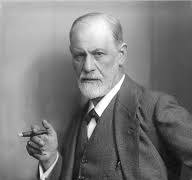By Prof. Levine & Dr. Salganik
Greetings to our readers,
Freud is described in the introduction to the book "Dr. Freud Biography" by Paul Ferris "as a man with raging passions, who grew up in a culture that suppresses passions and who strived with all his heart to understand those passions that drive him…. An obsessed genius, sometimes evil, sometimes generous, here and there also mischievous . and Ferris is convinced that, like other pioneering researchers, Freud more than once hitched the cart before the horse….to draw the conclusions that seemed right to him at a given moment."
Is that so?
This time we will discuss in detail the figures that accompanied Freud's life and influenced his personality and the psychoanalytic thought he created and which were internalized in his directory of internalized figures. We will also try to maintain the hierarchy of these images in his inner world.
We will also add that we used various sources including Encyclopedia Britannica, the entry on Freud's life and thought in Wikipedia and Erich Fromm's writings on Freud, among other sources. We will also note that due to the fact that we will show different angles, there will be several repetitions of the same significant figures, each time in a different context.
Brief Biography
Sigmund (Shlomo) Freud was born on May 6, 1856 to Ukrainian Jewish parents, Amalia and Jacob Freud, in Freiburg, Moravia, a small town that was then part of the Austrian Empire. In his early childhood, Freud and his family moved to Leipzig and then to Vienna. Freud was a brilliant student, studied literature, biology and medicine, and graduated with a medical degree from the University of Vienna in 1881.

Sigmund Shlomo Freud [1856-1939]
Freud read widely as a young student, and his later theories were likely influenced by scientists and scholars of his time, as well as prominent continental philosophers, such as Nietzsche and Schopenhauer. Freud was also a devoted reader of Shakespeare, whose literary influence is evident in many of Freud's works.
Read more »
By Prof. Levine & Dr. Salganik
שלום רב לקוראנו,
זיגמונד שלמה פרויד מתואר בהקדמה לספר ד"ר פרויד ביוגרפיה מאת פול פריס " כאדם בעל יצרים גועשים, שגדל בתרבות מדכאת יצרים ושאף בכל מאודו להבין את אותם יצרים המניעים אותו…. גאון אחוז אובססיה, מרושע לפעמים, נדיב לפעמים, פה ושם גם שובב. ופריס משוכנע כי כמו חוקרים אחרים פורצי דרך, פרויד רתם לא אחת את העגלה לפני הסוסים….כדי להסיק את המסקנות שנראו לו נכונות ברגע נתון."
האמנם?
הפעם נדון בהרחבה בדמויות שליוו את חייו של פרויד והשפיעו על אישיותו וההגות הפסיכואנליטית שיצר ואשר הופנמו בדירקטוריון הדמויות המופנמות שלו. נשתדל גם לעמוד על ההיררכיה של דמיות אלו בעולמו הפנימי. כמו כן, נוסיף שהשתמשנו במקורות שונים כולל אנציקלופדיה בריטניקה, הערך על פרויד חייו והגותו בויקיפדיה וכתביו של אריך פרום על פרויד לצד מקורות אחרים . נעיר גם כי בשל העובדה שנאיר זוויות שונות תהיינה חזרות מספר של אותן דמויות משמעותיות, בכל פעם בהקשר אחר.
זיגמונד (שלמה) פרויד נולד ב-6 במאי 1856 להורים יהודים אוקראינים, עמליה ויעקב פרויד, בפרייבורג שבמורביה, עיירה קטנה שהייתה אז חלק מהאימפריה האוסטרית. בילדותו המוקדמת עברו פרויד ומשפחתו ללייפציג ולאחר מכן לווינה. פרויד היה תלמיד מבריק, למד ספרות, ביולוגיה ורפואה, וסיים תואר ברפואה באוניברסיטת וינה בשנת 1881.

זיגמונד שלמה פרויד [ 1939- 1856]
פרויד הרבה לקרוא כסטודנט צעיר, והתיאוריות המאוחרות שלו הושפעו ככל הנראה ממדענים וחוקרים בני זמנו, כמו גם מפילוסופים קונטיננטליים בולטים, כמו ניטשה ושופנהאואר. פרויד היה גם קורא מסור של שייקספיר, שהשפעתו הספרותית ניכרת ברבות מיצירותיו של פרויד.
Read more »
By Prof. Levine & Dr. Salganik
Greetings,
Antisocial personality disorder (ASPD) is classified under cluster B of personality disorders in the American diagnostic and classification system known as DSM-5. It is diagnosed more in men than in women. This gender difference may be due to a combination of biological, social and cultural factors.
Antisocial personality disorder is characterized by a long-term pattern of manipulating, exploiting, or violating the rights of others. This disorder is often associated with criminal behavior and substance abuse, making it a significant concern in both clinical and legal settings.
ASPD is not a monolithic condition and can manifest in different forms, often overlapping with other personality disorders. Some researchers propose different subtypes based on specific traits and behaviors:
Aggressive/hostile type: characterized by open aggression, irritability and frequent physical confrontations.
Deceptive/Manipulative Type: Exhibits chronic lying, manipulation, and devious behaviors to take advantage of others.
Impulsive/Risk-Taking Type: Exhibits high impulsivity, lack of foresight, and engaging in risky behaviors without considering the consequences.
Tough/unemotional type: characterized by a deep lack of empathy, shallow emotions and a cold and detached demeanor.

AI-assisted demo
Read more »
By Prof. Levine & Dr. Salganik
שלום רב
הפרעת אישיות אנטי-חברתית (ASPD) מסווגת תחת אשכול B של הפרעות אישיות בשיטת האבחון והקלסיפיקציה האמריקאית המכונה- DSM-5. היא מאובחנת יותר אצל גברים מאשר אצל נשים. הבדל מגדרי זה עשוי לנבוע משילוב של גורמים ביולוגיים, חברתיים ותרבותיים.
הפרעת אישיות אנטי-חברתית מאופיינת בדפוס ארוך טווח של מניפולציה, ניצול או הפרה של זכויותיהם של אחרים. הפרעה זו קשורה לעתים קרובות להתנהגות פלילית ושימוש בסמים, מה שהופך אותה לדאגה משמעותית הן במסגרות קליניות והן במסגרות משפטיות.
ASPD אינו מצב מונוליטי והוא יכול להתבטא בצורות שונות, לעתים קרובות בחפיפה להפרעות אישיות אחרות. חלק מהחוקרים מציעים תת-סוגים שונים המבוססים על תכונות והתנהגויות ספציפיות:
סוג תוקפני/עוין: מאופיין בתוקפנות גלויה, עצבנות ועימותים פיזיים תכופים.
סוג רמאי/מניפולטיבי: מפגין שקרים כרוניים, מניפולציות והתנהגויות ערמומיות כדי לנצל אחרים.
טיפוס אימפולסיבי/לקיחת סיכונים: מפגין אימפולסיביות גבוהה, חוסר ראיית הנולד ומעורבות בהתנהגויות מסוכנות מבלי לקחת בחשבון את ההשלכות.
טיפוס קשוח/לא רגשי: מאופיין בחוסר אמפתיה עמוק, רגשות רדודים והתנהגות קרה ומנותקת.

הדגמה בעזרת AI
Read more »
By Prof. Levine & Dr. Salganik
Greetings to our readers
We assume that the individual's "social self" consists of the internalization of influential figures in one’s life, arranged in a hierarchical order [the group of these internalizations we metaphorically called the board of internal figures], where one or more internalized figures have the greatest influence on the individual's attitudes, feelings and behavior, which we called "the leader self" [a character who in the past was also called "the dictator self," see previous conversations]. It is possible that, similar to short-term memory, parts of which are transferred to long-term memory, even with regard to the internalization of characters, there is a short-term internalization that, depending on the circumstances, the importance and duration of the character's influence, will eventually be transferred to long-term internalization in the directorate of internalized characters.
Below we will discuss the structure of the social self: it consists of "secondary selves" which include the following types: 1) a variety of "self-representations" that originate from attitudes and feelings towards the self and its representations in different periods of life 2] representations of internalized figures that originate from the significant figures that the person is exposed to during his life, but as mentioned, there may also be imaginary characters represented in books, movies, etc. that have had a great impact on the person. 3] internalized representations of "subculture" [subculture refers to social influences in the environment in which a person lives and are not necessarily related to a specific person].

AI assisted picture: Board of Internalized Characters. The large figure expresses the internalized inner leader
Such a theoretical background in which the "social self" of the individual consists of internalizations of influential figures arranged in a hierarchical order, can perhaps explain processes in the author's creative process, as a process influenced by the dynamics of such an internalized hierarchy of figures in the writer's soul, which we called as mentioned in the metaphor "directorate of internalized characters" or "the board of the internalized characters".
Read more »
By Prof. Levine & Dr. Salganik
שלום רב לקוראנו
אנו מניחים ש"העצמי החברתי" של הפרט מורכב מהפנמה של דמויות משפיעות בחייו, המסודרות בסדר היררכי [קבוצת הפנמות אלו כינינו במטפורה דירקטוריון או מנהלת הדמויות הפנימיות] , כאשר לדמות מופנמת אחת או יותר יש את ההשפעה הגדולה ביותר על עמדותיו, רגשותיו והתנהגותו של הפרט, שקראנו לה או להם "המנהיג/ים העצמי/ים" [ דמות שבעבר כונתה גם "הדיקטטור העצמי," ראו שיחות קודמות]. יתכן שבדומה לזיכרון קצר מועד שחלקים ממנו מועברים לזיכרון ארוך טווח אף לגבי הפנמת דמויות קיימת הפנמה קצרת טווח שבתלות בנסיבות, בחשיבות ומשך זמן השפעת הדמות, זו תועבר להפנמה ארוכת טווח בדירקטוריון הדמויות.
להלן נדון במבנה העצמי החברתי: הוא מורכב מ"עצמיים משניים" הכוללים את הסוגים הבאים: 1) מגוון "יצוגיי האני" שמקורם בעמדות וברגשות כלפי העצמי וייצוגיו בתקופות שונות בחיים 2] ייצוגים של דמויות מופנמות שמקורן בדמויות המשמעותיות שהאדם נחשף אליהן במהלך חייו, אבל כאמור ייתכנו גם דמויות דמיוניות המיוצגות בספרים, סרטים וכו' 'שהשפיעו מאוד על האדם. 3] ייצוגים מופנמים של "תת-תרבות" [תת-תרבות מתייחסת להשפעות חברתיות בסביבה בה האדם חי ואינן קשורות בהכרח לאדם מסוים].

איור בעזרת AI: דירקטוריון הדמויות המופנמות. הדמות הגדולה מבטאת את המנהיג הפנימי המופנם
רקע תיאורטי כזה שבו "העצמי החברתי" של הפרט מורכב מהפנמות של דמויות משפיעות המסודרות בסדר היררכי, יכול אולי להסביר תהליכים בהליך היצירה של הסופר, כתהליך המושפע מהדינמיקה של היררכיה מופנמת כזו של דמויות בנפשו של הסופר, שכינינו אותה כאמור במטפורה "דירקטוריון הדמויות המופנמות" או "מנהלת הדמויות המופנמות".
Read more »
By Prof. Levine & Dr. Salganik
מצמוץ עיניים מוגדר רפלקס שפותח ועוצם את העיניים לסירוגין. מצמוץ ממלא תפקיד חיוני בעין המסייע למסך את פניה בדמעות ומסיר חומרים מגרים מפני השטח של הקרנית והלחמית. למצמוץ עשוי להיות פונקציות אחרות שכן המצמוץ מתרחש לעתים קרובות יותר מהנדרש רק בכדי לשמור על העין לחה. המצמוץ מפזר את הפרשת הדמעות על גלגלי העיניים ושומר על העיניים לחות, מסיר תאים מתים, דמעות שייבשו ופסולת אחרת מהעיניים.

יש להבדיל מיצמוץ ממיוקימיה (myokymia), או אדוות שרירים, שהיא רעידה בלתי רצונית וספונטנית של שרירים בגוף. התופעה יכולה לקרות בשרירים המקיפים את העיניים [עין קופצת בשפת העם] ובדרך כלל הינה חולפת תוך זמן קצר כמספר שניות אך לעיתים המצב עלול להמשך זמן רב יותר. גורמים אפשריים הינם עייפות יתר, לחץ נפשי, תשישות צריכת קפאין מופרזת או תופעת לואי של תרופות.
יש להבדיל מצמוץ גם מתופעת ה"בלפרוספזם" (blepharospasm). זהו מצב בו השרירים האחראים על סגירת העיניים ועל הורדת הגבות מתכווצים באופן בלתי רצוני. כאשר התופעה קלה היא באה ליידי ביטוי במצמוצי עיניים מהירים, במצב קשה יותר מתכווצים השרירים למשך זמן קצר עד ארוך ואף עד לסגירה לחלוטין של העפעף.
Read more »

 Prof. Joseph Levine, M.D. is an emeritus associate professor in the Division of Psychiatry, Faculty of Health Sciences, Ben Gurion University in Israel. Prof. Levine is a certified psychiatrist with clinical experience in controlled trials of adult psychiatric disorders and in psychotherapy. He was awarded a NRSAD independent investigator grant for the study of Creatine Monohydrate in psychiatric disorders -- mainly Schizophrenia. He resides and treats patients in Tel Aviv and all of central Israel.
Prof. Joseph Levine, M.D. is an emeritus associate professor in the Division of Psychiatry, Faculty of Health Sciences, Ben Gurion University in Israel. Prof. Levine is a certified psychiatrist with clinical experience in controlled trials of adult psychiatric disorders and in psychotherapy. He was awarded a NRSAD independent investigator grant for the study of Creatine Monohydrate in psychiatric disorders -- mainly Schizophrenia. He resides and treats patients in Tel Aviv and all of central Israel.





